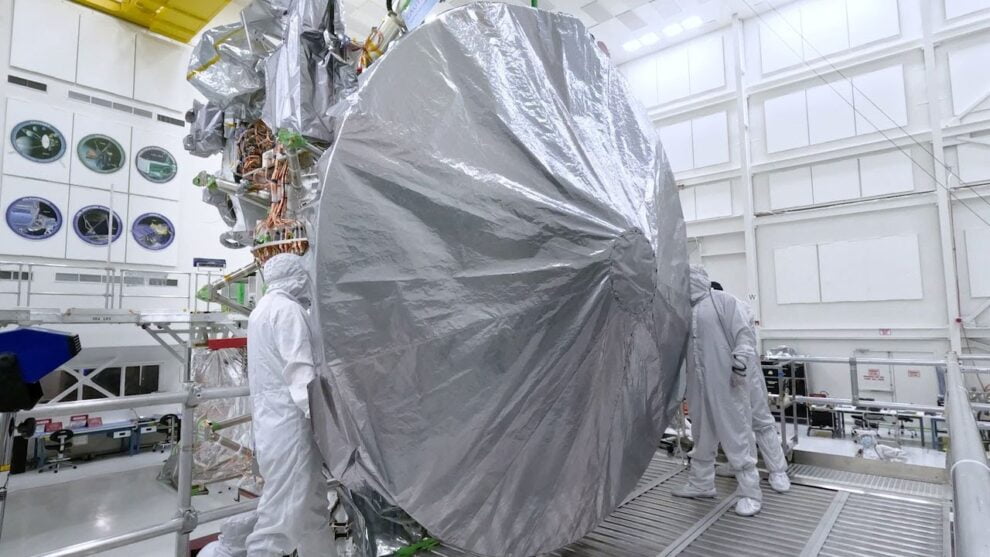The addition of a high-gain antenna will enable the agency’s Europa Clipper spacecraft – set to launch in October 2024 – to communicate with mission controllers hundreds of millions of miles away.
NASA’s Europa Clipper is designed to seek out conditions suitable for life on an ice-covered moon of Jupiter. On Aug. 14, the spacecraft received a piece of hardware central to that quest: the massive dish-shaped high-gain antenna.
Stretching 10 feet (3 meters) across the spacecraft’s body, the high-gain antenna is the largest and most prominent of a suite of antennas on Europa Clipper. The spacecraft will need it as it investigates the ice-cloaked moon that it’s named after, Europa, some 444 million miles (715 million kilometers) from Earth. A major mission goal is to learn more about the moon’s subsurface ocean, which might harbor a habitable environment.
Once the spacecraft reaches Jupiter, the antenna’s radio beam will be narrowly directed toward Earth. Creating that narrow, concentrated beam is what high-gain antennas are all about. The name refers to the antenna’s ability to focus power, allowing the spacecraft to transmit high-powered signals back to NASA’s Deep Space Network on Earth. That will mean a torrent of science data at a high rate of transmission.
The precision-engineered dish was attached to the spacecraft in carefully choreographed stages over the course of several hours in a Spacecraft Assembly Facility bay at NASA’s Jet Propulsion Laboratory in Southern California. “The antenna has successfully completed all of its stand-alone testing,” said Matthew Bray a few days before the antenna was installed. “As the spacecraft completes its final testing, radio signals will be looped back through the antenna via a special cap, verifying that the telecom signal paths are functional.”
Based at the Johns Hopkins University Applied Physics Laboratory in Laurel, Maryland, Bray is the designer and lead engineer for the high-gain antenna, which he began working on 2014. It’s been quite a journey for Bray, and for the antenna.
Just over the past year, he’s seen the antenna crisscross the country in the lead-up to the installation. Its ability to beam data precisely was tested twice in 2022 at NASA’s Langley Research Center in Hampton, Virginia. Between those two visits, the antenna made a stop at NASA’s Goddard Space Flight Center in Greenbelt, Maryland, for vibration and thermal vacuum testing to see if it could handle the shaking of launch and the extreme temperatures of outer space.
Then it was on to JPL in October 2022 for installation on the spacecraft in preparation for shipment next year to NASA’s Kennedy Space Center in Florida.
The long journey to Jupiter begins with launch from Kennedy in October 2024.
Europa in Their Sights
“The high-gain antenna is a critical piece in the buildup of Europa Clipper,” said Jordan Evans, the Clipper project manager at JPL. “It represents a very visible piece of hardware that provides the capability that the spacecraft needs to send the science data back from Europa. Not only does it look like a spacecraft now that it has the big antenna, but it’s ready for its upcoming critical tests as we progress towards launch.”
The spacecraft will train nine science instruments on Europa, all producing large amounts of rich data: high-resolution color and stereo images to study its geology and surface; thermal images in infrared light to find warmer areas where water could be near the surface; reflected infrared light to map ices, salts, and organics; and ultraviolet light readings to help determine the makeup of atmospheric gases and surface materials.
Clipper will bounce ice-penetrating radar off the subsurface ocean to determine its depth, as well as the thickness of the ice crust above it. A magnetometer will measure the moon’s magnetic field to confirm the deep ocean’s existence and the thickness of the ice.
The precision-engineered dish was attached to the spacecraft in carefully choreographed stages over the course of several hours in a Spacecraft Assembly Facility bay at NASA’s Jet Propulsion Laboratory in Southern California. “The antenna has successfully completed all of its stand-alone testing,” said Matthew Bray a few days before the antenna was installed. “As the spacecraft completes its final testing, radio signals will be looped back through the antenna via a special cap, verifying that the telecom signal paths are functional.”
Based at the Johns Hopkins University Applied Physics Laboratory in Laurel, Maryland, Bray is the designer and lead engineer for the high-gain antenna, which he began working on 2014. It’s been quite a journey for Bray, and for the antenna.
Just over the past year, he’s seen the antenna crisscross the country in the lead-up to the installation. Its ability to beam data precisely was tested twice in 2022 at NASA’s Langley Research Center in Hampton, Virginia. Between those two visits, the antenna made a stop at NASA’s Goddard Space Flight Center in Greenbelt, Maryland, for vibration and thermal vacuum testing to see if it could handle the shaking of launch and the extreme temperatures of outer space.
Then it was on to JPL in October 2022 for installation on the spacecraft in preparation for shipment next year to NASA’s Kennedy Space Center in Florida.
The long journey to Jupiter begins with launch from Kennedy in October 2024.
Europa in Their Sights
“The high-gain antenna is a critical piece in the buildup of Europa Clipper,” said Jordan Evans, the Clipper project manager at JPL. “It represents a very visible piece of hardware that provides the capability that the spacecraft needs to send the science data back from Europa. Not only does it look like a spacecraft now that it has the big antenna, but it’s ready for its upcoming critical tests as we progress towards launch.”
The spacecraft will train nine science instruments on Europa, all producing large amounts of rich data: high-resolution color and stereo images to study its geology and surface; thermal images in infrared light to find warmer areas where water could be near the surface; reflected infrared light to map ices, salts, and organics; and ultraviolet light readings to help determine the makeup of atmospheric gases and surface materials.
Clipper will bounce ice-penetrating radar off the subsurface ocean to determine its depth, as well as the thickness of the ice crust above it. A magnetometer will measure the moon’s magnetic field to confirm the deep ocean’s existence and the thickness of the ice.
Source: NASA











